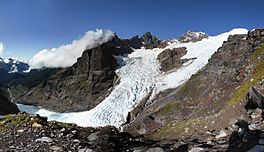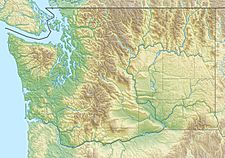Deming Glacier (Washington) facts for kids
Quick facts for kids Deming Glacier |
|
|---|---|

Deming Glacier
|
|
| Type | Mountain glacier |
| Coordinates | 48°45′47″N 121°50′20″W / 48.76306°N 121.83889°W |
| Length | 2.25 mi (3.62 km) |
| Terminus | Moraine/talus |
| Status | Retreating |
The Deming Glacier is a large ice mass found on Mount Baker in the North Cascades mountains. Mount Baker is located in the U.S. state of Washington. Glaciers like Deming Glacier are important because they show us how the Earth's climate is changing.
Contents
What is Deming Glacier?
Deming Glacier is a type of glacier known as a mountain glacier. It is a huge, slow-moving river of ice. This glacier sits on the southwest side of Mount Baker. It is next to the Easton Glacier on its east side. To its west, you'll find the Black Buttes ridge.
Where is Deming Glacier Located?
Deming Glacier is in Whatcom County, Washington, in the United States. It is high up on Mount Baker, which is a large volcano. The glacier is part of the beautiful North Cascades National Park area.
How Does Deming Glacier Change?
Glaciers are always changing. They can grow bigger (advance) or shrink (retreat). This happens because of changes in temperature and snowfall. Scientists study these changes to understand our planet's climate.
Retreat and Advance
Deming Glacier has changed a lot over the years. From 1850 to 1950, it melted back about 7,217 feet (2,200 meters). That's like losing more than 22 football fields of ice!
Then, from 1950 to 1979, the weather became cooler and wetter. This helped the glacier grow forward by about 2,060 feet (628 meters). But since 1980, the glacier has started to shrink again. Between 1980 and 2006, it retreated another 1,140 feet (347 meters). This shows how sensitive glaciers are to climate shifts.
Why Are Glaciers Important?
Glaciers like Deming Glacier are very important for many reasons. They store a lot of fresh water. This water melts slowly and feeds rivers and streams. These rivers provide drinking water for people and animals. They also help farmers grow crops.
Glaciers are also like giant thermometers for the Earth. When they melt quickly, it tells us that the planet is getting warmer. Studying glaciers helps scientists learn about past climates. It also helps them predict future climate changes.


